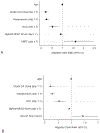Clinical and Neurologic Outcomes in Acetaminophen-Induced Acute Liver Failure: A 21-Year Multicenter Cohort Study
- PMID: 32920216
- PMCID: PMC10656032
- DOI: 10.1016/j.cgh.2020.09.016
Clinical and Neurologic Outcomes in Acetaminophen-Induced Acute Liver Failure: A 21-Year Multicenter Cohort Study
Abstract
Background & aims: Acetaminophen (APAP)-induced acute liver failure (ALF) is a rare disease associated with high mortality rates. This study aimed to evaluate changes in interventions, psychosocial profile, and clinical outcomes over a 21-year period using data from the ALF Study Group registry.
Methods: A retrospective review of this prospective, multicenter cohort study of all APAP-ALF patients enrolled during the study period (1998-2018) was completed. Primary outcomes evaluated were the 21-day transplant-free survival (TFS) and neurologic complications. Covariates evaluated included enrollment cohort (early, 1998-2007; recent, 2008-2018), intentionality, psychiatric comorbidity, and use of organ support including continuous renal replacement therapy (CRRT).
Results: Of 1190 APAP-ALF patients, recent cohort patients (n = 608) had significantly improved TFS (recent, 69.8% vs early, 61.7%; P = .005). Recent cohort patients were more likely to receive CRRT (22.2% vs 7.6%; P < .001), and less likely to develop intracranial hypertension (29.9% vs 51.5%; P < .001) or die by day 21 from cerebral edema (4.5% vs 11.6%; P < .001). Grouped by TFS status (non-TFS, n = 365 vs TFS, n = 704), there were no differences in psychiatric comorbidity (51.5% vs 55.0%; P = .28) or intentionality (intentional, 39.7% vs 41.6%; P = .58). On multivariable logistic regression adjusting for vasopressor support, development of grade 3/4 hepatic encephalopathy, King's College criteria, and MELD score, the use of CRRT (odds ratio, 1.62; P = .023) was associated with significantly increased TFS (c-statistic, 0.86). In a second model adjusting for the same covariates, recent enrollment was associated significantly with TFS (odds ratio, 1.42; P = .034; c-statistic, 0.86).
Conclusions: TFS in APAP-ALF has improved in recent years and rates of intracranial hypertension/cerebral edema have decreased, possibly related to increased CRRT use.
Keywords: Cerebral Edema; Continuous Renal Replacement Therapy Intracranial Hypertension; Transplant-Free Survival; Transplantation.
Copyright © 2021 AGA Institute. Published by Elsevier Inc. All rights reserved.
Figures
References
-
- Larson AM, Polson J, Fontana RJ, et al. Acetaminophen-induced acute liver failure: results of a United States multicenter, prospective study. Hepatology. 2005;42(6):1364–72. Epub 2005/12/01. - PubMed
-
- Bernal W, Hyyrylainen A, Gera A, et al. Lessons from look-back in acute liver failure? A single centre experience of 3300 patients. J Hepatol. 2013;59(1):74–80. Epub 2013/02/27. - PubMed
-
- O’Grady J, Williams R. Classification of acute liver failure. The Lancet. 1993;342(8873):743. - PubMed
-
- Bernal W, Wendon J. Acute liver failure. N Engl J Med. 2013;369(26):2525–34. Epub 2013/12/27. - PubMed
Publication types
MeSH terms
Substances
Grants and funding
LinkOut - more resources
Full Text Sources


